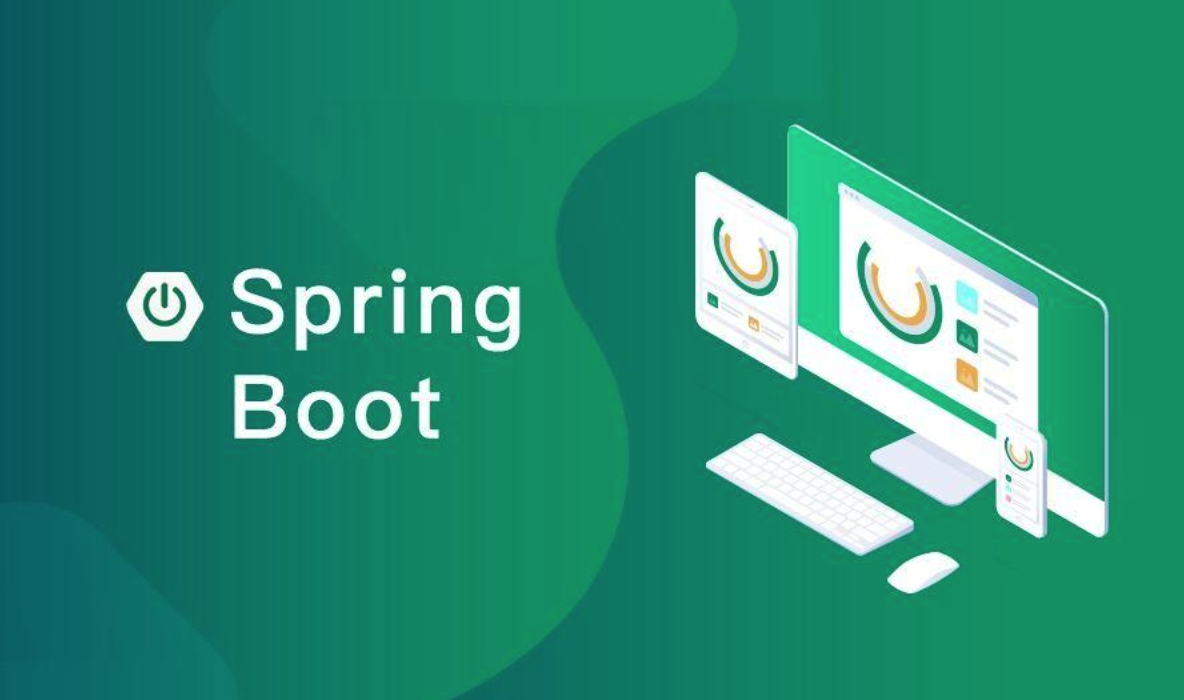
在本教程中,我们将研究标准Spring框架和Spring Boot之间的区别。
我们将重点讨论Spring的模块,如MVC和Security,在核心Spring中使用时与在Boot中使用时的区别。
Spring是什么?
简单地说,Spring框架为开发Java应用程序提供了全面的基础设施支持。
它包含了一些很好的功能,比如依赖注入,以及一些现成的模块,比如:
- Spring JDBC
- Spring MVC
- Spring Security
- Spring AOP
- Spring ORM
- Spring Test
这些模块可以大大缩短应用程序的开发时间。
例如,在java web开发的早期,我们需要编写大量样板代码来将记录插入到数据源中。通过使用springjdbc模块的JDBCTemplate,我们可以用很少的配置将它简化为几行代码。
Spring Boot是什么?
Spring Boot基本上是Spring框架的扩展,它消除了设置Spring应用程序所需的样板配置。
它对Spring平台持固执己见的观点,它为更快、更高效的开发生态系统铺平了道路。
以下是Spring Boot的一些功能:
- 持约定优于配置的“
starter”依赖关系,以简化构建和应用程序配置 - 嵌入式服务器避免了应用程序部署的复杂性
- 度量、运行状况检查和外部化配置
- 自动配置-只要可能
让我们逐步熟悉这两个框架。
Maven依赖项
首先,让我们看看使用Spring创建web应用程序所需的最小依赖性:
<dependency>
<groupId>org.springframework</groupId>
<artifactId>spring-web</artifactId>
<version>5.3.5</version>
</dependency>
<dependency>
<groupId>org.springframework</groupId>
<artifactId>spring-webmvc</artifactId>
<version>5.3.5</version>
</dependency>与Spring不同,Spring Boot只需要一个依赖项即可启动并运行web应用程序:
<dependency>
<groupId>org.springframework.boot</groupId>
<artifactId>spring-boot-starter-web</artifactId>
<version>2.4.4</version>
</dependency>在构建期间,所有其他依赖项都会自动添加到最终存档中。
另一个很好的例子是测试库。我们通常使用一组Spring-Test、JUnit、Hamcrest和Mockito库。在Spring项目中,我们应该添加所有这些库作为依赖项。
或者,在springboot中,我们只需要starter依赖项就可以自动包含这些库。
springboot为不同的Spring模块提供了许多启动程序依赖项。最常用的方法有:
- spring-boot-starter-data-jpa
- spring-boot-starter-security
- spring-boot-starter-test
- spring-boot-starter-web
- spring-boot-starter-thymeleaf
要获得starters的完整列表,还可以查看Spring文档:https://docs.spring.io/spring-boot/docs/current/reference/htmlsingle/#using-boot-starter
MVC配置
让我们研究一下使用Spring和SpringBoot创建jsp web应用程序所需的配置。
Spring需要定义dispatcherservlet、映射和其他支持配置。我们可以用web.xml文件或初始值设定项类:
public class MyWebAppInitializer implements WebApplicationInitializer {
@Override
public void onStartup(ServletContext container) {
AnnotationConfigWebApplicationContext context
= new AnnotationConfigWebApplicationContext();
context.setConfigLocation("com.baeldung");
container.addListener(new ContextLoaderListener(context));
ServletRegistration.Dynamic dispatcher = container
.addServlet("dispatcher", new DispatcherServlet(context));
dispatcher.setLoadOnStartup(1);
dispatcher.addMapping("/");
}
}我们还需要将@EnableWebMvc注释添加到@Configuration类中,并定义一个视图解析器来解析从控制器返回的视图:
@EnableWebMvc
@Configuration
public class ClientWebConfig implements WebMvcConfigurer {
@Bean
public ViewResolver viewResolver() {
InternalResourceViewResolver bean
= new InternalResourceViewResolver();
bean.setViewClass(JstlView.class);
bean.setPrefix("/WEB-INF/view/");
bean.setSuffix(".jsp");
return bean;
}
}相比之下,在添加web starter后,Spring Boot只需要几个属性就可以工作:
spring.mvc.view.prefix=/WEB-INF/jsp/
spring.mvc.view.suffix=.jsp通过一个名为auto-configuration的process添加bootwebstarter,上面所有的Spring配置都会自动包含进来。
这意味着springboot将查看应用程序中存在的依赖项、属性和bean,并基于它们启用配置。
当然,如果我们想添加我们自己的自定义配置,那么Spring-Boot自动配置就会退出。
配置模板引擎
现在让我们学习如何在Spring和springboot中配置Thymeleaf模板引擎。
在Spring中,我们需要为视图解析器添加thymeleaf-spring5依赖项和一些配置:
@Configuration
@EnableWebMvc
public class MvcWebConfig implements WebMvcConfigurer {
@Autowired
private ApplicationContext applicationContext;
@Bean
public SpringResourceTemplateResolver templateResolver() {
SpringResourceTemplateResolver templateResolver =
new SpringResourceTemplateResolver();
templateResolver.setApplicationContext(applicationContext);
templateResolver.setPrefix("/WEB-INF/views/");
templateResolver.setSuffix(".html");
return templateResolver;
}
@Bean
public SpringTemplateEngine templateEngine() {
SpringTemplateEngine templateEngine = new SpringTemplateEngine();
templateEngine.setTemplateResolver(templateResolver());
templateEngine.setEnableSpringELCompiler(true);
return templateEngine;
}
@Override
public void configureViewResolvers(ViewResolverRegistry registry) {
ThymeleafViewResolver resolver = new ThymeleafViewResolver();
resolver.setTemplateEngine(templateEngine());
registry.viewResolver(resolver);
}
}SpringBoot只需要springbootstarter thymeleaf的依赖性就可以在web应用程序中启用thymeleaf支持。由于Thymeleaf3.0中的新特性,我们还必须在springboot2web应用程序中添加thymeleaf-layout-dialect作为依赖项。或者,我们可以选择添加一个springbootstarter和eleaf依赖,它将为我们处理所有这些。
一旦依赖项就位,我们就可以将模板添加到src/main/resources/templates文件夹中,Spring引导将自动显示它们。
Spring Security 配置
为了简单起见,我们将看到如何使用这些框架启用默认的HTTP基本身份验证。
让我们先看看使用Spring启用安全性所需的依赖项和配置。
Spring需要标准的springsecurityweb和springsecurityconfig依赖项来设置应用程序中的安全性。
接下来,我们需要添加一个类来扩展WebSecurityConfigureAdapter并使用@EnableWebSecurity注释:
@Configuration
@EnableWebSecurity
public class CustomWebSecurityConfigurerAdapter extends WebSecurityConfigurerAdapter {
@Autowired
public void configureGlobal(AuthenticationManagerBuilder auth) throws Exception {
auth.inMemoryAuthentication()
.withUser("user1")
.password(passwordEncoder()
.encode("user1Pass"))
.authorities("ROLE_USER");
}
@Override
protected void configure(HttpSecurity http) throws Exception {
http.authorizeRequests()
.anyRequest().authenticated()
.and()
.httpBasic();
}
@Bean
public PasswordEncoder passwordEncoder() {
return new BCryptPasswordEncoder();
}
}这里我们使用inMemoryAuthentication来设置身份验证。
springboot还需要这些依赖项才能工作,但是我们只需要定义spring-boot-starter-security的依赖项,因为这样会自动将所有相关的依赖项添加到classpath类路径中。
springboot中的security安全配置与上面的相同。
要了解如何在Spring和Spring引导中实现JPA配置,我们可以查看我们的文章A Guide To JPA with Spring:https://www.baeldung.com/the-persistence-layer-with-spring-and-jpa
Application Bootstrap
在Spring和Spring引导中引导应用程序的基本区别在于servlet。Spring使用web.xml或SpringServletContainerInitializer作为其引导入口点。
另一方面,SpringBoot只使用Servlet3特性来引导应用程序。我们来详细谈谈。
Spring如何引导?
Spring既支持传统的web.xml引导方式以及最新的Servlet3+方法。
让我们看看web.xml分步进近:
1. Servlet容器(服务器)读取web.xml.
2.DispatcherServlet定义在web.xml中由容器实例化。
3. DispatcherServlet通过读取WEB-INF/{servletName}创建WebApplicationContext-servlet.xml.
4. 最后,DispatcherServlet注册在应用程序上下文中定义的bean。
下面是如何使用Servlet3+方法进行Spring引导:
1. 容器搜索实现ServletContainerInitializer的类并执行。
2. SpringServletContainerInitializer查找实现WebApplicationInitializer的所有类。
3. WebApplicationInitializer使用XML或@Configuration类创建上下文。
4. WebApplicationInitializer使用先前创建的上下文创建DispatcherServlet。
如何启动Spring Boot?
Spring Boot应用程序的入口点是用@SpringBootApplication注释的类:
@SpringBootApplication
public class Application {
public static void main(String[] args) {
SpringApplication.run(Application.class, args);
}
}默认情况下,springboot使用嵌入式容器来运行应用程序。在本例中,springboot使用public static void主入口点来启动嵌入式web服务器。
它还负责将Servlet、Filter和servletContextInitializerbean从应用程序上下文绑定到嵌入式Servlet容器。
springboot的另一个特性是,它自动扫描主类的同一个包或子包中的所有类中的组件。
此外,springboot还提供了将其部署为外部容器中的web存档的选项。在这种情况下,我们必须扩展SpringBootServletInitializer:
@SpringBootApplication
public class Application extends SpringBootServletInitializer {
// ...
}在这里,外部servlet容器查找在web存档的META-INF文件中定义的主类,SpringBootServletInitializer将负责绑定servlet、过滤器和ServletContextInitializer。
打包和部署
最后,让我们看看如何打包和部署应用程序。这两个框架都支持Maven和Gradle等常见的包管理技术;但是,在部署方面,这些框架有很大的不同。
例如,springboot maven插件在Maven中提供springboot支持。它还允许打包可执行jar或war,并“就地”运行应用程序
在部署环境中,Spring Boot优于Spring的一些优点包括:
- 提供嵌入式容器支持
- 设置为使用命令
java-jar独立运行jar - 用于排除依赖项的选项,以避免在外部容器中部署时发生潜在的jar冲突
- 用于在部署时指定活动配置文件的选项
- 集成测试的随机端口生成
结论
在本文中,我们了解了Spring和Spring Boot之间的区别。
简而言之,我们可以说springboot只是Spring本身的一个扩展,它使开发、测试和部署更加方便。
除特别注明外,本站所有文章均为老K的Java博客原创,转载请注明出处来自https://javakk.com/1776.html




 在这个努力程度如此低下的时代,还轮不到比拼天赋。静下心来,just do it
在这个努力程度如此低下的时代,还轮不到比拼天赋。静下心来,just do it

暂无评论